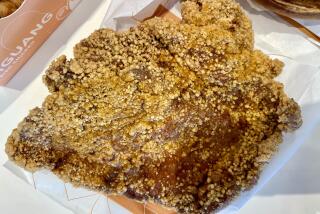McDonald’s China strategy
- Share via
NEW YORK — For nearly two decades in China, the KFC logo has enticed the hungry with the promise of juicy, crispy chicken.
Now, Yum Brands Inc. -- which owns KFC and Pizza Hut as well as Taco Bell in the U.S. -- has some competition for the cravings of Chinese diners.
After watching Yum gobble up much of China’s emerging middle class, McDonald’s Corp., which has 800 restaurants in operation in China, is ramping up development in the country.
“The businesses are years apart maturity wise, but we believe Yum’s business can remain the primary driver of corporate profitability and McDonald’s’ business can become a measurable contributor to its own,” said JPMorgan Chase & Co. analyst John Ivankoe in a note to investors, after he met with both companies’ teams in China this month.
At Yum, the China business helped hasten a recovery after a string of problems in its U.S. business, including an E. coli outbreak at some Taco Bell restaurants on the East Coast and a rat infestation at a KFC/Taco Bell franchise in New York.
“It is clearly our number one growth strategy,” said Yum spokesman Jonathan Blum of the chain’s China operation.
Blum said Yum is now opening about one restaurant per day in China and has plans to open 375 KFC restaurants by the end of 2007.
Along with its fried chicken, KFC’s 1,940 mainland China locations offer customers several options meant to appeal to Chinese diners, such as a rice porridge dish known as pi dan congee.
The company also has the natural advantage of a strong cultural taste for chicken. Pork and chicken have traditionally been more popular than beef among the Chinese. Raising cattle requires a lot of grazing land that China needs for farming.
Blum says the company’s success can be at least partly explained by its distribution system, which is much bigger than its competitors and allows it access to parts of the country farther away from main city centers.
Friedman, Billings, Ramsey analyst Ashley Woodruff said that investment has paid off.
“Yum’s distribution system in China is second only to the Chinese Army’s, allowing Yum to open stores in provinces and cities McDonald’s may not reach for 10 years,” Woodruff said in an analyst note.
Woodruff said Yum has also focused on food safety. Yum visits each distribution center 10 times per year unannounced to test for quality controls and does surprise audits of its suppliers.
McDonald’s lacks some of the scale of the Yum operation. But the company plans to open at least 125 new stores per year beginning in 2008. The chain currently has about 800 stores there.
Instead of beating Yum by opening more locations, McDonald’s is looking to two niche areas for growth -- drive-throughs and locations open all night.
Deutsche Bank analyst Jason West said the strategy might help McDonald’s make up for lost time.
“We believe McDonald’s has an opportunity to establish a niche as the dominant drive-through player in the Chinese market,” West said in a note to investors. “While KFC clearly dominates the market for in-line fast-food chain restaurants, it is not making an aggressive push into drive-through.”
McDonald’s made some headway in June last year, when it announced a 20-year agreement with Sinopec, China’s state-owned and largest petroleum retailer, to build drive-through restaurants at Sinopec gas stations throughout the country.
The company opened its first drive-through in 2005 and its first Sinopec location in January. Half of the new stores opened in 2008 will have drive-throughs. In comparison, Yum Brands has only opened about 10 drive-throughs.
Deutsche Bank’s West added McDonald’s drive-throughs have reported sales 15% to 20% higher than non-drive-through locations.
Rather than playing catch-up by developing more restaurants faster, Owens said McDonald’s can do well by implementing the strategy that fueled its success in the U.S.
“Focus on being better, not on being bigger,” he said.
More to Read
Inside the business of entertainment
The Wide Shot brings you news, analysis and insights on everything from streaming wars to production — and what it all means for the future.
You may occasionally receive promotional content from the Los Angeles Times.










